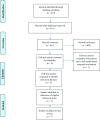Systematic Review of Economic Models Used to Compare Techniques for Detecting Peripheral Arterial Disease
- PMID: 29687330
- PMCID: PMC6393284
- DOI: 10.1007/s41669-018-0076-1
Systematic Review of Economic Models Used to Compare Techniques for Detecting Peripheral Arterial Disease
Abstract
Background and objective: Peripheral arterial disease (PAD) is a common condition, in which atherosclerotic narrowing in the arteries restricts blood supply to the leg muscles. In order to support future model-based economic evaluations comparing methods of diagnosis in this area, a systematic review of economic modelling studies was conducted.
Methods: A systematic literature review was performed in June 2017 to identify model-based economic evaluations of diagnostic tests to detect PAD, with six individual databases searched. The review was conducted in accordance with the methods outlined in the Centre for Reviews and Dissemination's guidance for undertaking reviews in healthcare, and appropriate inclusion criteria were applied. Relevant data were extracted, and studies were quality assessed.
Results: Seven studies were included in the final review, all of which were published between 1995 and 2014. There was wide variation in the types of diagnostic test compared. The majority of the studies (six of seven) referenced the sources used to develop their model, and all studies stated and justified the structural assumptions. Reporting of the data within the included studies could have been improved. Only one identified study focused on the cost-effectiveness of a test typically used in primary care.
Conclusions: This review brings together all applied modelling methods for tests used in the diagnosis of PAD, which could be used to support future model-based economic evaluations in this field. The limited modelling work available on tests typically used for the detection of PAD in primary care, in particular, highlights the importance of future work in this area.
Conflict of interest statement
Relationships with entities that have a financial interest in the subject matter of the article have been clearly stated in the Conflict of Interest Disclosure Statements provided by Andrew Sims and John Allen. These relationships relate to their employment by the Newcastle upon Tyne Hospitals (NUTH) NHS Foundation Trust, which received grant income from the National Institute for Health Research to develop the diagnostic device outlined previously. Authors Eoin Moloney, Joanne O’Connor, Dawn Craig, Shannon Robalino, Alexandros Chrysos, Mehdi Javanbakht, Gerard Stansby and Scott Wilkes have no conflicts of interest to report.
Figures
Similar articles
-
Folic acid supplementation and malaria susceptibility and severity among people taking antifolate antimalarial drugs in endemic areas.Cochrane Database Syst Rev. 2022 Feb 1;2(2022):CD014217. doi: 10.1002/14651858.CD014217. Cochrane Database Syst Rev. 2022. PMID: 36321557 Free PMC article.
-
Rapid antigen detection and molecular tests for group A streptococcal infections for acute sore throat: systematic reviews and economic evaluation.Health Technol Assess. 2020 Jun;24(31):1-232. doi: 10.3310/hta24310. Health Technol Assess. 2020. PMID: 32605705 Free PMC article.
-
Defining the optimum strategy for identifying adults and children with coeliac disease: systematic review and economic modelling.Health Technol Assess. 2022 Oct;26(44):1-310. doi: 10.3310/ZUCE8371. Health Technol Assess. 2022. PMID: 36321689 Free PMC article.
-
Beyond the black stump: rapid reviews of health research issues affecting regional, rural and remote Australia.Med J Aust. 2020 Dec;213 Suppl 11:S3-S32.e1. doi: 10.5694/mja2.50881. Med J Aust. 2020. PMID: 33314144
-
Toe-brachial index and toe systolic blood pressure for the diagnosis of peripheral arterial disease.Cochrane Database Syst Rev. 2024 Oct 30;10(10):CD013783. doi: 10.1002/14651858.CD013783.pub2. Cochrane Database Syst Rev. 2024. PMID: 39474992 Free PMC article.
Cited by
-
Cost-effectiveness analysis of intraoperative radiation therapy versus external beam radiation therapy for the adjuvant treatment of early breast cancer: A systematic review.Med J Islam Repub Iran. 2020 Dec 10;34:167. doi: 10.47176/mjiri.34.167. eCollection 2020. Med J Islam Repub Iran. 2020. PMID: 33816366 Free PMC article. Review.
-
Automated devices for identifying peripheral arterial disease in people with leg ulceration: an evidence synthesis and cost-effectiveness analysis.Health Technol Assess. 2024 Aug;28(37):1-158. doi: 10.3310/TWCG3912. Health Technol Assess. 2024. PMID: 39186036 Free PMC article.
References
-
- NHS Choices. Peripheral arterial disease (PAD). 2014. https://www.nhs.uk/conditions/peripheral-arterial-disease-pad/. Accessed 15 Sep 2016.
Publication types
Grants and funding
LinkOut - more resources
Full Text Sources
Other Literature Sources


